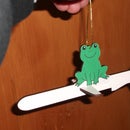Introduction: How to Devise a Useless Phonetic Alphabet
The NATO Phonetic [1] Alphabet has been in use for over sixty years. It was created after much research into how best to transmit information over noisy telephone or radio links.
It has survived almost unchanged as it is very effective in avoiding miscommunication.
However, it is predicated on the unexamined assumption that communication is good. Since I am not convinced of this I have decided to create an alternative phonetic alphabet which is intended to make it as difficult as possible to communicate clearly over a noisy channel. Or even over a clear one.
[1] It is not a "phonetic" alphabet, but a "spelling" alphabet. However, NATO has more nuclear weapons than I do and so I'm not going to cavil at their phraseology.
Supplies
To make your own copy, you will need a printer able to print out the PDF and a frame in which to put it.
To create your own version, you will need an astonishing amount of time and a very twisted imagination.
Attachments
Step 1: History
A need for unambiguous communication over crackly telephone lines began with the first crackly telephone lines, and the first standard was defined in 1904 for use by the British Army. This did not define every letter, but had effects beyond its lifetime, with phrases like "ack emma" being used long after the rest of the language had disappeared.
Various others came and went, with civil aviation being an early use case. The International Civil Aviation Organisation (ICAO)had an easier job than some international standard setters as there was a requirement for all civil aviation radio communications to be in English. Despite that their early attempts were fragmented with an alphabet in use in the northern hemisphere completely different to that used in Latin America.
After WWII the problem was approached scientifically for the first time, and in the late 1940s the ICAO collaborated with linguists at Montreal University to develop an unambiguous alphabet.
There were five requirements given by the ICAO. Each word must:-
1 Be a live word in each of the three working languages. (English, French and Spanish)
2 Be easily pronounced and recognized by airmen of all languages.
3 Have good radio transmission and readability characteristics.
4 Have a similar spelling in at least English, French, and Spanish, and the initial letter must be the letter the word identifies.
5 Be free from any association with objectionable meanings.
These requirements have been modified in order to further the goal of unintelligibility.
For the revised alphabet, each word must comply with:-
1 The initial letter of the word must be the letter which the word identifies.
2 The word must be a live word in English or a common Christian name.
The second requirement was added in deference to the NATO word for "C", "M", "O", "R" and "V", none of which are "live" words in any of the three languages referenced by ICAO, but rather are Christian names, popular in various countries.
Step 2: "Crazy ABCs" Song
As the initial work on the ICAO alphabet was done in Canada, it seemed only fitting to start with the Canadian rock band "The Barenaked Ladies" and their track "Crazy ABC's". This provided a structure around which to build the final alphabet, even though very few of their words survived the evolutionary process.
Their alphabet contains _almost_ every letter, where their requirements seem to have been:-
1 Initial letter is the same as the letter encoded
2 Initial letter is silent if possible
3 Word is uncommon.
Generally speaking this was a solid start, but some of the choices were frankly poor, such as "Argyle" for the letter "R" (also violates rule one) and there had been very little attempt to ensure confusion between the words.
The use of uncommon words deserves some respect, but confusion must be sown in all minds, not merely those with limited vocabularies, and so changes must be made.
Attachments
Step 3: Adding Homophones
The weakest feature of the first draft was the absence of homophones and so a determined effort was made to produce as many words as possible which sounded identical.
This also helped to solve the problem of letters which had few or no words where the inital letter was silent. Claiming that "Llama" has a silent "L" because it has two "L"s and only one is sounded is really reaching.
Sought, Thought and Wrought made a nice grouping, especially as "Sought" and "Thought" would cause particular problems for non-native English speakers.
The issue of "Argyle" was addressed by using the Korean name "Rodong" which is pronounced "Nodong".
The real breakthrough in this stage of development came with the adoption of "IOU" as the word for "I". Not only did it immediately call for the words "Eye", "Owe" and "Yew" for perfect confusion, but it also opened the door to other abbreviations. Most noticeably, "Lb" is a perfectly common English word for a mass of 454g and is pronounced "Pownd."
Other languages were also tapped, with Afrikaans providing "Uitlander" and "Veldt" to give unexpectedly pronounced words for those two difficult letters.
"Zsolt" was another happy discovery. It is a Hungarian Christian name, also held by a surprising number of American and Canadian sportsmen. You live and learn.
Another win at this stage was realising that "Mnemonic" and "Pneumonic" would be so easily confused.
Attachments
Step 4: Refining
In this refinement, it became necessary to abandon some old friends. "Bdellometer" (a cupping glass used by Roman doctors or modern massage therapists) had to go. It had been my favourite word for several weeks (ever since I had discovered it) but with the adoption of "Lb" as "Pound" there was a need for an easily confused word and most of the alternatives were required for the "-aught" project. Accordingly "Bdellometer" was out and "Bound" was in.
Another apparent simplification was replacing "Gnaw" (silent 'G') with "Gin". As the original creators of the ICAO alphabet discovered, every word depends on every other word, and while "Gnaw" aided with confusion around "Naught", that left the handy word "Djinn" standing clear. To reduce the hamming distance, we had to slight reduce the "-aught" confusion in order to have a homophone for "Djinn".
The name "Zsolt" was further investigated. A surprisingly large range of pronounciations are allowed for this name, and so its official pronounciations was changed from "Djolt" to "Djot". This required the letter "J" to be "Jot" rather than "Jolt" but adds further confusion to the "-aught" sound, eliminating the clarity added by "Gin".
Attachments
Step 5: Final Version
By this stage there were few of the original words left, and given the changes which had been made, those remaining ones were the focus of the last push.
"Uitlander" and "Heir" fell into place as "Umber" and "Humber", particularly given the difficulties experienced by francophones with an initial aspirate. While there are no rivers in the NATO alphabet, there is a country (India) and a city (Quebec) and so geographical names are obviously perfectly acceptable.
"Rodong", like "Bdellometer" was a favourite of mine, but emotion must play no part in a technical endeavour, and so it was out. Replacing it with "Round" added greatly to the "Bound"/"Lb" confusion.
The only remaining "silent letter" words are "Qat" and "Veldt" and since both "cat" and "felt" are very common English words it was believed that sufficient confusion would attach to those words that could pass as they were. We also sacrificed "Found" to be "Felt" which ensured that at least one of the two had a homophone.
Attachments
Step 6: Preparing for Printing
The NATO Phonetic Alphabet as displayed on wiki includes the morse code for each letter, and since that is obsolete and deprecated, I felt that it was a fair inclusion for my alphabet too.
Using dots and dashes for the morse left the dots well below the line of the dashes (or the dashes well above the dots) and looked rather naff. Each dot had to be selected individually and then given the character attribute of "Superscript" at 100% size and raised by 17%. For a different font/word-processor that will need to be tweaked, but I was delighted to discover that such attributes could be tweaked and I look forward to so doing in other projects.
The pronounciations given are probably not perfectly in accordance with the system used by NATO, but given both the intent and the implementation of this project, I wasn't going to lose any sleep over that.
Lastly I shelled out on a high-quality print on heavy stock and hung the framed piece on the wall.
Now all that remains is to persuade the billion people who currently use the NATO alphabet to switch to this one.

Participated in the
Anything Goes Contest 2021














